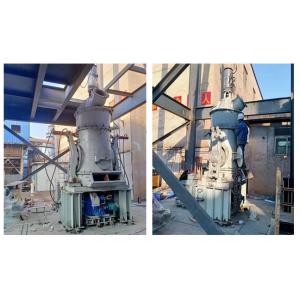
Add to Cart
Low Energy Consumption Vertical Mill For Cement / Slag / Raw Material / Coal Grinding Mill
The main components of cement raw meal are generally limestone, clay, iron powder, etc. The raw materials are mixed according to a certain proportion and then crushed and ground, and the finished product is cement raw meal. According to whether it contains coal or not, cement raw meal is divided into white raw meal (without coal), black raw meal (with coal) and semi-black raw meal (with some coal). Raw meal containing coal is generally used in shaft kilns. There are many kinds of cement raw meal production processes, such as dry, wet, semi-dry and semi-wet. Large-scale raw meal vertical mill is a good choice for dry cement raw meal preparation.
The cement raw meal is calcined at high temperature in a rotary kiln or a shaft kiln, resulting in a series of chemical reactions to generate clinker with calcium carbonate as the main component. Cement clinker plus a certain proportion of gypsum or other mixed materials are ground by a large vertical mill, and finally turned into a finished cement product. Hengcheng's large-scale raw meal vertical mill and large-scale clinker vertical mill are reliable production equipment for cement plants, and have obvious advantages in increasing production and reducing consumption and environmental protection.
【Main features of the product】
1. High efficiency and energy saving
High grinding efficiency and low energy consumption, compared with ball mills, the energy consumption is 40%-50% lower;
Large single machine production capacity
2. Easy maintenance and low operating cost
Maintenance work is very convenient;
The service life of wear-resistant materials;
High degree of automation and easy operation
3. Low comprehensive investment cost
It integrates crushing, drying, grinding and conveying, with simple process flow, less system equipment, compact structure and layout, and small footprint, which is only 50% of the ball mill.
4. Stable product quality
The product quality is stable; the product particle shape is uniform, the particle size distribution is narrow, the fluidity is good, and the product adaptability is strong.
5. High reliability
Reliable sealing and excellent explosion suppression performance.
6. Environmental protection
The whole system of HVM vertical mill has small vibration and low noise; no dust spillage
Specifications And Technical Parameters Of HVM Raw Vertical Mill
| Model | HVM2500 | HVM2800 | HVM3400 | HVM3700 | HVM4200 | HVM4500 | HVM4800 | HVM5100 | HVM5600 |
| grinding table median diameter(mm) | 2500 | 2800 | 3400 | 3700 | 4200 | 4500 | 4800 | 5100 | 5600 |
| Capacity(t/h) | 85-100 | 130-160 | 190-240 | 240-300 | 320-400 | 400-500 | 440-550 | 550-670 | 600-730 |
| Raw Material Moisture | <10% | ||||||||
| Raw Meal Fineness | R0.08<12% | R0.08<14% | |||||||
| Raw Meal Moistrue | ≤1% | ||||||||
| Main Motor Power(kW) | 800/900 | 1120/1250 | 1800/2000 | 2500/2800 | 3150/3350 | 3800/4200 | 4200/4500 | 5000/5400 | 5600/6000 |
| Illustrate | Re:Raw materials bond index≤13kWh/t | ||||||||

【An Introduction】
HVM vertical mill can produce both coarse powder and ultra-fine powder, and can produce coarse powder from 2 to 5 mm for materials with different product fineness requirements (such as grinding shale, raw materials for brick making in the new wall material industry, and sand making in the construction industry). etc.) to 15 micron ultrafine powder with a pass rate of 97% (such as heavy calcium powder in the paper industry, activated carbon ultrafine powder in the chemical industry), the product fineness adjustment is highly arbitrary, and the adaptability is wide.
【Solution】
For the production of coarse powder, the structure of the powder separator with low resistance and anti-wear should be adopted when selecting the type of the vertical mill. At the same time, due to the large number of large particles, necessary anti-wear treatment and powder separator structure design are required to achieve reasonable powder selection output and energy consumption;
For the production of ultra-fine powder, the vertical mill should focus on the design and optimization of the powder separator. Due to the large resistance of powder selection at this time, it is necessary to strictly control the fineness, and to prevent large particles from running thick, excessive blade wear and tear. Problems such as abnormal vibration caused by large internal resistance of the mill. Therefore, for materials with different product fineness requirements, it is necessary to calculate and analyze the smoothness of materials and gases in the vertical mill, especially the part of the powder separator, according to the characteristics of the material, so as to determine a reasonable structure of the powder separator (such as the rotor form and the number and angle of blades, the number and angle of stationary blades), and at the same time, necessary auxiliary means should be taken to control (such as using a sealed fan for gas sealing to effectively control the running of large particles).